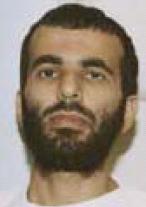|
|
|
Fahd Saleh Suleiman al Jutayli. Image courtesy of the SITE Intelligence Group. |
Al Qaeda in the Arabian Peninsula (AQAP) has released a biography of a former Guantanamo detainee named Fahd Saleh Suleiman al Jutayli, who was killed in 2009. The biography, which was translated by the SITE Intelligence Group, was written by another former Guantanamo detainee, Ibrahim Rubaish.
Rubaish is currently AQAP’s Mufti, or chief theologian, and is responsible for producing theological arguments and propaganda that can be used to justify his organization’s terror. [See LWJ report, Former Guantanamo detainee now al Qaeda in Arabian Peninsula’s Mufti.]
Rubaish’s biography of Jutayli is the sixth episode of AQAP’s “Martyrs of the Peninsula” series, according to SITE.
When Jutayli’s death was first reported in September 2009, the Saudi-backed Al Hayat newspaper based in London claimed that he was killed during a shootout between the Yemeni Army and the Shiite Houthi rebels. It was not clear why Jutayli was in the middle of this skirmish, but some accounts claimed he was fighting alongside the Houthis. [See LWJ report, Former Gitmo detainee killed in shootout.]
|
|
|
Ibrahim Suleiman al Rubaish, al Qaeda in Arabian Peninsula’s Mufti. |
Rubaish, however, bristles at the idea that Jutayli fought for the Houthis. Rubaish says that Jutayli was not killed fighting “under a banner that belongs to a sect that curses the early Muslim emigrants and supporters” – that is, Shiites.
After supposedly prophesying his own death, Rubaish says, Jutayli “trained with some of his brothers with bombs, during which one of the bombs exploded at them and he was the closest to it.” Jutayli “was instantly killed,” the SITE translation of Rubaish’s message reads, “then the rest of the brothers joined him.”
Rubaish lists several radical Muslim clerics who Jutayli either supposedly studied or met with prior to his demise. One of the clerics is Sheikh Abu Muhammad al Maqdisi, whose writings Jutayli read. Maqdisi was formerly a spiritual mentor to the deceased leader of al Qaeda in Iraq, Abu Musab al Zarqawi. Maqdisi and Zarqawi disagreed over the indiscriminate killing of Shiites in Iraq, leading the two to have a falling out. Maqdisi remains one of the most widely cited clerics in jihadist circles.
Rubaish’s listing of clerics who influenced Jutayli’s life is part of AQAP’s ongoing theological debate with the Saudi religious establishment. AQAP seeks to justify its operations by citing clerics who approve of its jihad. Some Muslim clerics, including members of the Saudi religious establishment, have tried to undermine AQAP’s theological arguments by claiming, among other things, that jihad can only be waged when it has been sanctioned by Muslim rulers. Rubaish and AQAP ideologue Anwar al Awlaki have sought to undermine this position repeatedly in their propaganda statements, arguing that individual jihad is the duty of all Muslims regardless of whether or not Muslim authorities approve.
“Medium” threats
Both Jutayli and Rubaish were considered “medium” threats to US security during their time at Guantanamo, according to leaked Joint Task Force Guantanamo (JTF-GTMO) threat assessments.
Jutayli was repatriated to Saudi Arabia in May 2006 and enrolled in the Saudi government’s jihadist rehabilitation program. Just over one year earlier, on April 1, 2005, JTF-GTMO recommended that Jutayli be transferred to another country for continued detention. Previously, the leaked file notes, JTF-GTMO recommended on November 22, 2003 that Jutayli be retained in the Department of Defense’s custody.
Ultimately, Jutayli was released from the Saudi rehabilitation program and fled to Yemen, where he joined AQAP.
According to the leaked April 2005 threat assessment, JTF-GTMO concluded that Jutayli was “a low-level member” of al Qaeda “who went to Afghanistan…for the purpose of receiving jihadist training” after being influenced by Saudi clerics to do so. Jutayli stayed at al Qaeda-run guesthouses and trained at an al Qaeda-run training camp, “both of which were closely associated” with Osama bin Laden.
During his combatant status review tribunal (CSRT) at Guantanamo, Jutayli conceded that he was trained at al Qaeda’s al Farouq camp.
After the Taliban fell in late 2001, Jutayli fled to the Tora Bora Mountains. JTF-GTMO found he went there “with a weapon,” but “conducted unknown activities.” Jutayli was later captured in Pakistan.
Jutayli’s name was found on several al Qaeda lists of captured mujahideen. One of these lists was stored on Khalid Sheikh Mohammed’s hard drive, which was captured along with KSM on March 1, 2003 in Pakistan. “This list denoted that [Jutayli] was considered a mujahideen by al Qaeda,” JTF-GTMO’s analysts found.
Rubaish’s account, ironically, confirms JTF-GTMO’s analysis in important ways. Rubaish says that Jutayli was dissatisfied with his life and decided to “join the convoy of mujahideen in the land of Afghanistan,” the SITE translation reads. Jutayli “was in Tora Bora at the time of the intense bombing,” Rubaish explains, adding that Jutayli retreated alongside Taliban forces to Pakistan.
Rubaish claims that Jutayli rebelled against the guards at Guantanamo for the sake of his fellow detainees and had his beard and head shaved as punishment. The leaked JTF-GTMO file tells the other side of the story, reporting that Jutayli was “non-compliant during his detention” and had a “relatively high amount of disciplinary reports.”
In another leaked threat assessment, dated November 30, 2005, JTF-GTMO concluded that Rubaish was an al Qaeda member who traveled to Afghanistan for jihad at the urging of Saudi clerics. The similarities to Jutayli do not end there. Rubaish trained at the al Farouq camp and retreated to Tora Bora in late 2001. Rubaish admitted to US authorities that he was under the command of a senior al Qaeda operative at Tora Bora.
Also like Jutayli, Rubaish’s name was found on a list of captured mujahideen that US authorities recovered from Khalid Sheikh Mohammed’s hard drive. The threat assessment contains an interesting bit of intelligence explaining how US authorities investigated the contents of KSM’s computer.
Top al Qaeda operative Abu Zubaydah, who was subjected to the CIA’s so-called enhanced interrogation techniques in 2002, was asked about KSM’s computer files. The questioning took place in 2003, months after Zubaydah was subjected to the harshest treatment, including waterboarding.
According to the JTF-GTMO threat assessment, Zubaydah “claimed the information was a record of people’s belongings left at KSM’s guesthouse.” Zubaydah explained that upon arrival at a guesthouse, the “brother left his passport, any other important papers, wallet, and other miscellaneous items, with an official of the guesthouse who would write [down] the brother’s original name, his nickname, and the articles the brother deposited.”
The JTF-GTMO file continues: “When asked to review the names on the listing, [Rubaish’s] name/alias was familiar to Abu Zubaydah.” No additional details are provided.
Unlike Jutayli, JTF-GTMO did not recommend Rubaish for transfer. Instead, JTF-GTMO concluded that Rubaish should be retained in DoD custody. Rubaish was repatriated to Saudi Arabia in December 2006 regardless.
The leaked JTF-GTMO threat assessment for Rubaish contains a possible clue as to why. In 2002, Saudi Arabia sent a delegation to Guantanamo. Afterwards, Saudi Arabia’s domestic intelligence agency, the Mabahith, identified Rubaish “as one of the seventy-seven Saudi nationals of low intelligence value and law enforcement value to the US Government but of whom the Saudi Government would attempt to prosecute if transferred to their custody from Guantanamo Bay.”
JTF-GTMO disagreed with the Saudi assessment, concluding in 2005 that Rubaish’s “true intelligence value is not yet fully exposed” because there were “considerable gaps” in his story. Rubaish was still found to be of medium intelligence value to American authorities, as opposed to the Saudis’ “low” assessment, because of his numerous ties to al Qaeda operatives.
Despite Saudi Arabia’s offer, Rubaish was not prosecuted. He was enrolled in the Saudi jihadist rehabilitation program, released, and fled to Yemen where he joined AQAP.
An increasing number of former Guantanamo detainees have done the same, including Jutayli.










1 Comment
Saudi rehabilitation program = epic fail.
We could have told you that.